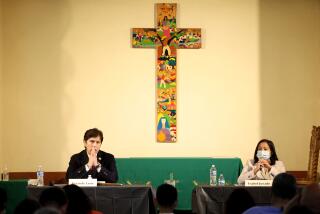South-Central Tax Would Beef Up Police
- Share via
Spurred by pleas to curb the soaring crime rate in South-Central Los Angeles neighborhoods, the City Council agreed Wednesday to draft a ballot measure that would impose a special tax in those areas to pay for putting 300 more police officers on the streets.
The levy could be as much as $11.75 a month for the average household.
The proposal by Councilman Robert Farrell, whose 8th District includes some of the most crime-plagued sections of the city, is aimed at placing a measure on the June 2 ballot seeking approval for a $21-million property tax increase to finance additional street officers.
Under the Farrell plan, which must return to the City Council for a final vote before it goes on the ballot, the owners of residential, commercial and industrial properties in a 43-square-mile area of South-Central Los Angeles would be asked to pay for extra police officers that the city contends it cannot afford.
If the measure reaches the ballot and is passed, property owners in neighborhoods covered by four Los Angeles Police Department divisions--the 77th, Southeast, Southwest and Newton--would pay higher taxes in exchange for increased police protection. Passage of the measure would mark the first time that residents of a separate section of Los Angeles would be required to pay extra for more police protection.
But Farrell, in a sometimes emotional debate with his colleagues, argued that emergency measures are needed to suppress the crime that has racked his community--”the narcotics trade, the gang (violence), the murders, the burglaries, the robberies.”
“You all would not tolerate that in your districts,” Farrell told his fellow council members. “Don’t you know what is going on in South Los Angeles?”
Although Police Chief Daryl F. Gates has expressed little optimism that voters would approve a property tax increase to pay for more officers, Assistant Police Chief Robert Vernon said Wednesday that the department backs Farrell’s plan because of the worsening crime rate in South-Central Los Angeles and throughout the city.
“We’re desperate,” Vernon said. “We think we’re going to have to go on a war footing. And you do a lot of things when you’re on a war footing.”
Police officials said there are about 1,100 officers now deployed by the four Los Angeles police divisions. And according to department statistics, the rates for homicides, robberies and burglaries in those neighborhoods are among the city’s worst.
For example, the Newton Division reported 140.6 serious crimes per 1,000 population in 1985--the highest total in the city. The Hollywood Division had the next highest crime rate with 134.7 per 1,000. But then came the Southwest Division in third place with 113.6 crimes per 1,000. And the 77th Division and Southeast Division ranked sixth and seventh, respectively, among the department’s 18 divisions.
About 500,000 people live in the areas that would be affected by a tax. And only voters in those areas receiving the added police protection would cast ballots on the property tax plan. Two-thirds approval is needed to pass the tax increase.
If adopted, the average homeowner would pay about $141 more a year in property taxes, according to preliminary estimates by the city administrative office. Commercial property owners, meanwhile, would pay an additional $275 a year and industrial taxpayers could expect a $794 increase in their property tax bills.
In the past, the council has rejected similar proposals, including an attempt several years ago to tax residents of San Fernando Valley.
But after encountering initial opposition Wednesday from council colleagues, Farrell mustered a 9-2 vote to instruct the city attorney’s office to draft the ballot measure language.
The Farrell proposal is patterned after two citywide police tax measures that were rejected by voters in 1981 and 1985. Those proposals would have added as many as 1,400 more officers, but both measures were resoundingly defeated. But Farrell said a majority of voters in his 8th District and other South-Central Los Angeles areas voted in favor of the tax increases and are open to a property tax increase.
Despite Wednesday’s approval, the fate of the ballot measure remains uncertain with several council members indicating that they may oppose it when it returns.
“I definitely will vote against it,” said Councilman Hal Bernson, who had sided with the majority.
The two councilmen who opposed the measure Wednesday were Joel Wachs and Zev Yaroslavsky. Both said they feared that the tax plan would set a “dangerous” precedent for other essential city services, putting more affluent communities at an advantage.
“I think that you will rue the day when you start dividing this city up community by community in providing different and uneven levels of service. . . ,” Wachs said.
Melanie Lomax, vice president of the Southern California chapter of the National Assn. for the Advancement of Colored People, applauded Farrell’s proposal, calling it “the most creative solution any member of the City Council has come up with to the problem of police staffing in South-Central Los Angeles . . . .”
“The people in South-Central Los Angeles have been screaming for additional police resources,” she said. “Traditionally, the people there have voted in favor of imposing taxes for additional police. . . . They haven’t been able to get them any other way.” However, Mervin Evans, who is challenging Farrell in the April 14 election, told council members that the tax plan needs further study and described it as a “backdoor” political proposal.
Times staff writer Eric Malnic contributed to this article.
More to Read
Sign up for Essential California
The most important California stories and recommendations in your inbox every morning.
You may occasionally receive promotional content from the Los Angeles Times.










